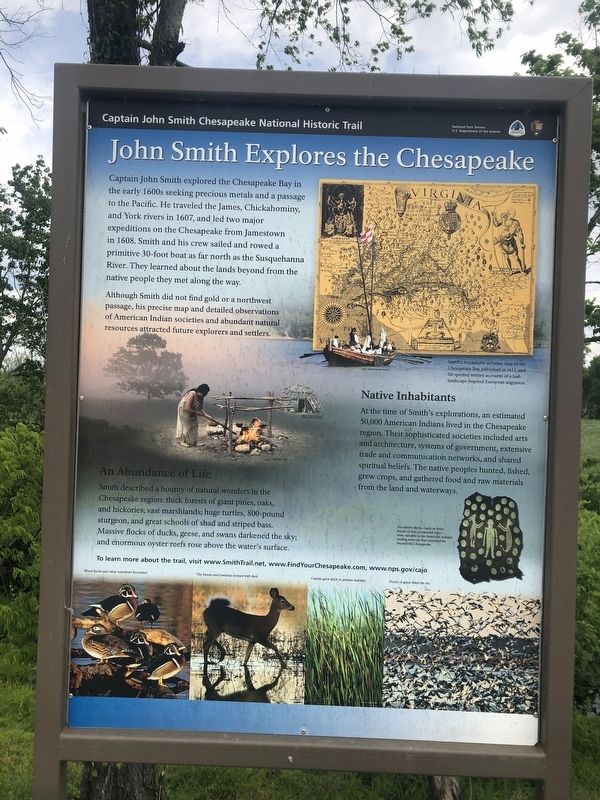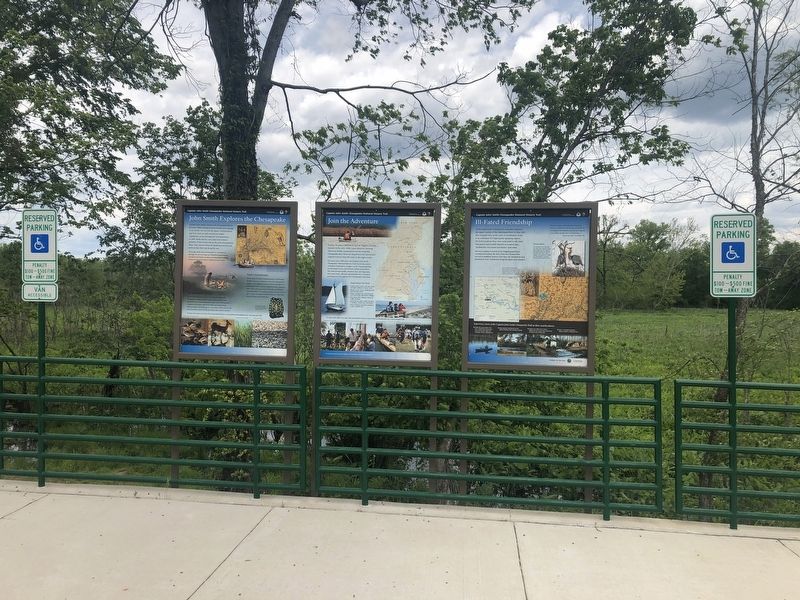Near Dutch Gap in Chesterfield County, Virginia — The American South (Mid-Atlantic)
John Smith Explores the Chesapeake
Captain John Smith Chesapeake National Historic Trail
— National Park Service, U.S. Department of the Interior —
Captain John Smith explored the Chesapeake Bay in the early 1600s seeking precious metals and a passage to the Pacific. He traveled the James, Chickahominy and York rivers in 1607, and led two major expeditions on the Chesapeake from Jamestown in 1608. Smith and his crew sailed and rowed a primitive 30-foot boat as far north as the Susquehanna River. They learned about the lands beyond from the native people they met along the way.
Although Smith did not find gold or a northwest passage, his precise map and detailed observations of American Indian societies and abundant natural resources attracted future explorers and settlers.
Native Inhabitants
At the time of Smith's explorations, an estimated 50,000 American Indians lived in the Chesapeake region. Their sophisticated societies included arts and architecture, systems of government, extensive trade and communication networks, and shared spiritual beliefs. The native peoples hunted, fished, grew crops, and gathered food and raw materials from the land and waterways.
An Abundance of Life
Smith described a bounty of natural wonders in the Chesapeake region: thick forests of giant pines, oaks, and hickories; vast marshlands; huge turtles, 800-pound sturgeon, and great schools of shad and striped bass. Massive flocks of ducks, geese, and swans darkened the sky; and enormous oyster reefs rose above the water's surface.
To learn more about the trail, visit www.SmithTrail.net, www.FindYourChesapeake.com, www.nps.gov/cajo
[Captions:]
Smith's remarkably accurate map of the Chesapeake Bay, published in 1612, and his spirited written accounts of a lush landscape inspired European migration.
Decorative shells—such as those found on this ceremonial robe—were valuable in the American Indians' trading network that extended far beyond the Chesapeake.
Erected by National Park Service, U.S. Department of the Interior.
Topics and series. This historical marker is listed in these topic lists: Colonial Era • Exploration • Native Americans • Waterways & Vessels. In addition, it is included in the Captain John Smith Chesapeake National Historic Trail series list. A significant historical year for this entry is 1607.
Location. 37° 22.451′ N, 77° 21.956′ W. Marker is near Dutch Gap, Virginia, in Chesterfield County. Marker is on Henricus Park Road, 1.4 miles east of Coxendale Road, on the left when traveling east. Touch for map. Marker is at or near this postal address: 421 Coxendale Rd, Chester VA 23836, United States of America. Touch for directions.
Other nearby markers. At least 8 other markers are within walking distance of this marker.
Credits. This page was last revised on May 9, 2020. It was originally submitted on May 9, 2020, by Devry Becker Jones of Washington, District of Columbia. This page has been viewed 108 times since then and 17 times this year. Photos: 1, 2. submitted on May 9, 2020, by Devry Becker Jones of Washington, District of Columbia.

